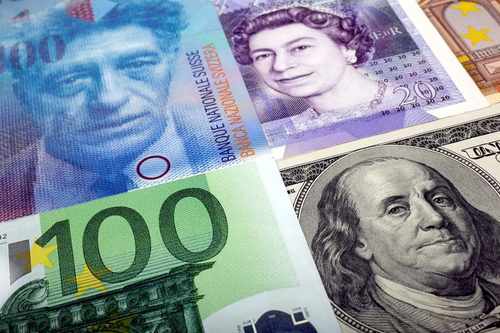As Treasury rates recovered off their 2-1/2-month lows, the dollar strengthened somewhat on Monday, after reports that the Omicron COVID-19 strain exhibited very minor symptoms.
In the wake of the Omicron news from South Africa, Wall Street reversed some of its losses from Friday.
Treasury yields on 10-year notes fell to their lowest level since September 30th, and the safe-haven currencies the Japanese yen and Swiss franc rose in value. A 0.4 percent drop in the dollar’s value versus the Japanese yen has occurred.
On top of that, the market’s expectations for the faster unwinding of stimulus and higher interest rates beginning next year were not shaken by Friday’s dollar losses, which came after a weaker-than-expected employment report. The dollar index rose by 0.1 percent to 96.29, which is within striking distance of November’s 16-month high of 96.938 points of the US dollar. The yen rose by 0.2 percent to 113.05 yen, while the franc rose by 0.4 percent.
An ING Bank FX strategist says that “the dollar capitalizes on the narrative of (Fed Chair Jerome) Powell sticking to its plans for a quicker tapering, which we had last week.” Dollar-euro rates fell by a tenth of a percent. It is also worth mentioning that the rising value of the dollar has a significant impact on financial markets such as Forex, the world’s biggest financial market. The increased demand for USD in the market is caused by the rising value of the dollar. Those participating in the FX market, on the other hand, are aware that the financial industry is volatile. As a result, they must discover the correct broker that will provide them with instruments to foresee future value changes in order to minimize losses. One of the most effective methods to choose the proper broker is to read reviews such as the FP Markets broker review, which provides detailed information about the financial service provider and how it functions. Furthermore, by reading evaluations, traders may learn more about the tools and services offered by the brokerage.
Australia’s currency, the Australian dollar, was up 0.5% to $0.7035 and scraped off its 13-month low, according to the Sydney Morning Herald. The kiwi rose by 0.1 percent to $0.6750 per dollar.
This week’s inflation data could further erode the yield curve, according to analysts, who expect it to continue to flatten.
The rest of the crypto market was battered by a wild weekend that saw bitcoin fall by more than 20%. At around $49,000, Bitcoin found support on Monday.
The Future Of Dollar
In the near future, the dollar will not lose its position as the world’s reserve currency, but the exchange rate will be more volatile. As a consequence, policymakers and companies alike will have a difficult time coping with the uncertainty and destabilizing fluctuations in cross-border financial flows. Recent research by McKinsey Global Institute has shown this. Is this a pricey perk?
Because of the US’s unwillingness to implement tougher fiscal and monetary policies, the dollar’s value is expected to fluctuate. The US serving as a magnet for global official reserves and liquid assets has detrimental consequences, according to new research. Higher dollar exchange rates have a negative impact on US exporters and US businesses that compete with imports.
Despite a busy central bank calendar week that includes the two-day meeting of the Federal Reserve, the dollar index remained above 96.3 on Tuesday, maintaining its strong position against a basket of key competitors. To keep pace with rising inflation and strong employment, the Federal Reserve is generally anticipated to announce a more rapid reduction in its asset purchases and an early start to rate rises. In November, the annual rate of inflation rose to 6.8%, the highest since 1982. It was still susceptible to the fast-spreading Omicron variety since the potential blow to the global economy would obscure the outlook and postpone stimulus and interest rate liftoffs.
However, monetary policy may be seen as an extension of a country’s exchange rate. Central bankers’ actions are reflected in these indicators. We may expect the Federal Reserve to impose some monetary constraint in 2023, and the dollar will rise in value as a result.
This year’s record-breaking gains in the stock market indicate that officials have succeeded in avoiding the Covid-19 epidemic from turning into a multi-year recession if equity markets are any indication. Worries about the strength of the recovery are moving to concerns about the course of inflation in the G10 nations.
Some insight into whether central bankers can take their time in normalizing loose monetary policy or need to move quickly in the face of an inflation danger may be gained by looking at output gaps, or how the economy is developing relative to its potential. The International Monetary Fund (IMF) expects positive production gaps in the United States (+3.3 percent) and Canada (+0.8 percent) in 2023. The Federal Reserve and the Bank of Canada should be first in line to tighten monetary policy, according to theory.
Since 2008, both the Eurozone and Japan have seen negative production gaps, which justifies the more dovish stances of the central banks in both countries.
The global economy is in mid-cycle right now, with increasing confidence in the recovery, rising inflation, and central banks beginning to tighten their monetary policies to stem the tide of deflation. As a result, commodity currencies should continue to perform strongly as their economies realize the advantages of recent terms of trade improvements via increased corporate investment.
The pound is likely to be somewhere in the middle of the following three currencies: a stronger dollar, a weaker low-yielding currency, and a stable commodities currency.
How can investors take advantage of the current situation with the dollar and Treasury yields?
Well, as always, it’s important to do your research and consider your risk tolerance before making any investment decisions. That being said, if you believe that the dollar will continue to rise and Treasury yields will claw back some of their losses, you might consider investing in assets that tend to perform well in that kind of environment, such as US equities. However, it’s always a good idea to consult with a financial advisor before making any investment decisions.
What is the outlook for the dollar and Treasury yields in the near future?
Unfortunately, predicting the future of the dollar and Treasury yields is a difficult task, as it depends on many unpredictable factors such as geopolitical events, monetary policy, and economic data releases. That being said, some analysts believe that the dollar will continue to rise and Treasury yields will trend higher in the coming months, while others see the opposite happening. As always, it’s important to stay informed and monitor any changes in the market to make informed investment decisions.
How does the rise in the dollar impact the value of foreign stocks and bonds?
It’s important to remember that the value of a currency can have a big impact on the value of stocks and bonds denominated in that currency. When the dollar rises, the value of foreign stocks and bonds can decrease, as they become more expensive for foreign investors. This can make these assets less attractive to foreign investors, leading to a decrease in demand and, in turn, a decrease in value.
How does the rise in the dollar impact the value of other currencies?
A rise in the value of the dollar can have a negative impact on the value of other currencies. When the dollar becomes more valuable, it becomes more expensive for foreign countries to purchase goods and services from the US, making exports from the US more expensive. This can lead to a decrease in demand for exports and a decrease in demand for the currency of the foreign country, causing its value to decrease.






